British Standards Compliant & Woolsafe Approved Services
All carpet & upholstery cleaning work compliant with British Standards & Woolsafe approved for wool fibres
Read Our Reviews
A Wealth of Experience in Carpet Cleaning and More
Since 2007, our family-run carpet cleaning business has been committed to quality services at competitive rates
Get In Touch
Trustworthy, Local, Family-Run Business in Ipswich
Our trustworthy local cleaners are part of a proud family-run business - see our reviews on Checkatrade
Learn About Us
Professional Upholstery Cleaning
Upholstery can be a very complex fabric, made up of many different types of fibres. These fibres need to be identified to ensure damage or problems do not arise from a cleaning process.
A good understanding of the construction and filling will prevent problems with odours, pile distortion and fraying when carrying out cleaning.
All fabric types can be cleaned with one of our tailored processes. These ensure cost effective results are achieved without risking common problems such as shrinkage, Pile distortion, Colour / texture change and colour migration. From maintaining a new appearance, to removing soils and greases creating a eye sore, we will have a solution to suit your needs.
Recommended by many interior designers, retailer and upholsterers for specific cleaning services and application of tailored protectors to new fabrics preventing permanent changes of appearance.
Upholstery Renewal: Freshen, Clean, and Restore
Although upholstery does not suffer from having the same type of soiling as carpets under footfall, it does filter soil and dust from the air, greases from skin, hair lacquer, gels and creams therefore becoming sticky and attracting further general soiling.
Each and every time we stand up and sit down, on and off a cushion, a vacuum effect is formed, acting as a filter system. These soils are abrasive and can change the appearance of the upholstery, causing it to look dull.
With professional cleaning, the dry soil and any other greasy deposits can be removed, giving the fibres a ’back to life’ appearance.
Reviving & Maintaining your Furniture
We have tailored cleaning processes for all fabric types and fibre types. These are typically cleaned in situ, however collection and delivery, with off site controlled cleaning is sometimes preferred, where storage can also be arranged when moving home / home renovations are taking place.
Fibres we commonly clean and apply protectors to include-
- Cotton
- Nylon
- Viscose
- Wool
- Polyester
- Silk
- Acrylic
- Tensile
Some manufactures do not clearly state the fibre type, rest assured we will be able to check the fibres and test for a suitable process to safely clean the fabric in question.
Common fabric types we clean and protect include –
- Velvet
- Crushed Velvet
- Flat woven fabrics
- Shag pile
- Buttoned designs
Here are a few of the common types of fabric types described were our delicate cleaning processes are tailored to maintain, or treat for more heavier soiling, or spots and stains.
Luxury fine fabrics are very delicate where specific combination processes are commonly used to clean with care.
We inspect all fabric types prior to cleaning to avoid possible issues that commonly arise when general cleaning processes are carried out.
Greasy soiling can on some fibres, cause a yellowing effect if exposed for too long. This can be permanent just like general soiling is abrasive and is important to remove regularly if you wish to keep your suite looking as good as new, year on year.
Carrying out a thorough inspection is always essential to check for shrinking, stretching, dye/colour transfer, filling materials, stain removal and strength in water to prevent any damage from occurring.
All cleaning types will start with a through vacuum to remove dust and soils from every square inch of the fabric. Once this is complete, stain removal will be carried out in preparation for the cleaning system.
Safeguarding you and your home | Why us?
Our step-by-step cleaning processes
Fibre Shampooing
A foaming agent is mixed and applied to the upholstery, agitated into the nap of the material, loosening the soils in the suite. The shampoo crystallises over a period of 16 hours and encapsulates soil enabling it to be vacuumed away as part of routine household cleaning.
Stage 1 -Thoroughly vacuum the fabric to remove all dry dust and dirt

Stage 2 – Carry our stain removal techniques if required.
Stage 3 – Foam up the tailored fibre shampoo agent.
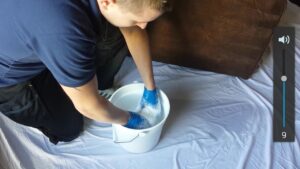
Stage 4 – Apply the foamed agent with sponge and work into nap of the fabric. The agent works up to 16 hours after application by dry in around 1 hour.
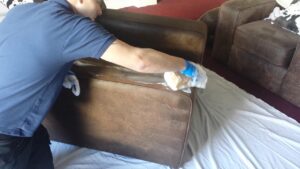
Stage 5 – Towel the fabric and set the nap
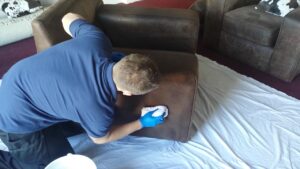
Stage 6 – Thoroughly vacuum the crystallized agent away after 16 hours.
Dry Cleaning
Dry cleaning systems are designed as a maintenance cleaning process for sensitive fibres that are likely to have unstable dyes in water. Their construction can shrink or stretch with moisture or so dry cleaning is excellent for fibres that may be liable to distortion with water based cleaning.
Dry cleaning is a solvent based process that does not contain water. This is still however wet and as solvents are heavier than water, can take longer to dry.
Often manufacturers will state “dry cleaning only” to ensure their fabrics are not attempted to be cleaned by a homeowner or unqualified company as solvents on most fibres will not have as many negative effects.
This form of cleaning can have limited results, due to the chemistry of how dirt and spot marks interact with fabrics, but our free inspection will help advise of the most effective process.
All fabrics are thoroughly vacuumed as a first step to remove dry dust, dirt and other insoluble items like hair, etc. Once prepared, the agent is gently applied to the fabric going with the weave to ensure no fluffing or plucking occurs. The agent is then absorbed out of the fabric along with the broken down dirt and greases.
Although the fabric will feel dry to touch, the solution can be in the fabric for a while so use may be restricted initially.
Surface Absorption
Our Surface absorption maintenance cleaning method is a light surface cleaning process ideal to be used as a regular cleaning process. It removes surface dirt that is not too ingrained through excessive wear, use and age. The process can be quick to carry out and dries within 20 minutes.
Stage 1- Thorough vacuum all fabric to remove all dry dirt and dust.
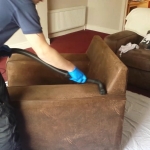
Stage 2- Stain removal attempts if needed.
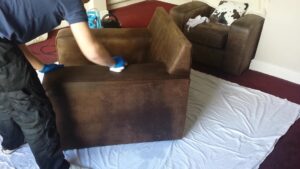
Stage 3- Apply self neutralising treatment tailored to fibres.
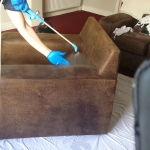
Stage 4- Agitate fabric with soft tampico brush to activate treatment and loosen dirt.
Stage 5- Absorb loosened dirt and moisture into absorbent towels.
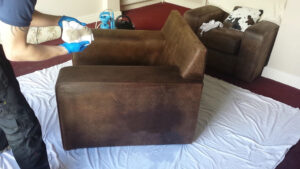
Stage 6- Brush and set nap of fabric.
Hot Water Extraction
Stage 1- Thoroughly vacuum fabric to remove all dry dust and dirt.
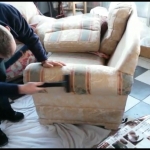
Stage 2- Attempt stain removal if required.
Stage 3- Apply pre-treatment to fabric that is tailored to the type of fibres.
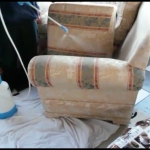
Stage 4- Agitate and detail any piping, etc, with soft tampico brush.
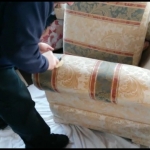
Stage 5- Use hot water extraction to rinse the pre-treatment and neutralise to the fabrics required specification.
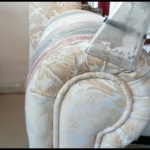
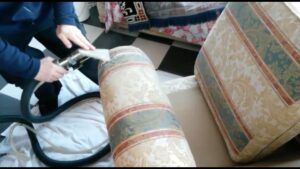
Stage 6- Use white towels to dry the fabric and check for further dirt. If any dirt is left in the fabric, the process is completed again.
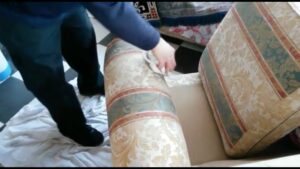
Stage 7- Use air blowers to dry the fabric as quickly as possible.








